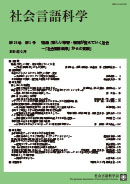Volume 23, Issue 1
Displaying 1-18 of 18 articles from this issue
- |<
- <
- 1
- >
- >|
Special Issue: New Approaches to Learning and Education: Contributions from the Sociolinguistic Sciences
Prefatory Note
-
2020Volume 23Issue 1 Pages 1-4
Published: September 30, 2020
Released on J-STAGE: October 07, 2020
Download PDF (309K)
Research Overviews
-
2020Volume 23Issue 1 Pages 5-20
Published: September 30, 2020
Released on J-STAGE: October 07, 2020
Download PDF (580K) -
2020Volume 23Issue 1 Pages 21-36
Published: September 30, 2020
Released on J-STAGE: October 07, 2020
Download PDF (592K)
Research Papers
-
2020Volume 23Issue 1 Pages 37-52
Published: September 30, 2020
Released on J-STAGE: October 07, 2020
Download PDF (502K) -
2020Volume 23Issue 1 Pages 53-68
Published: September 30, 2020
Released on J-STAGE: October 07, 2020
Download PDF (797K) -
2020Volume 23Issue 1 Pages 69-83
Published: September 30, 2020
Released on J-STAGE: October 07, 2020
Download PDF (4090K) -
2020Volume 23Issue 1 Pages 84-99
Published: September 30, 2020
Released on J-STAGE: October 07, 2020
Download PDF (2479K) -
2020Volume 23Issue 1 Pages 100-115
Published: September 30, 2020
Released on J-STAGE: October 07, 2020
Download PDF (3447K) -
2020Volume 23Issue 1 Pages 116-131
Published: September 30, 2020
Released on J-STAGE: October 07, 2020
Download PDF (1757K) -
2020Volume 23Issue 1 Pages 132-146
Published: September 30, 2020
Released on J-STAGE: October 07, 2020
Download PDF (1113K) -
2020Volume 23Issue 1 Pages 147-161
Published: September 30, 2020
Released on J-STAGE: October 07, 2020
Download PDF (2394K)
Research Papers
-
2020Volume 23Issue 1 Pages 162-177
Published: September 30, 2020
Released on J-STAGE: October 07, 2020
Download PDF (528K) -
2020Volume 23Issue 1 Pages 178-193
Published: September 30, 2020
Released on J-STAGE: October 07, 2020
Download PDF (546K) -
2020Volume 23Issue 1 Pages 194-209
Published: September 30, 2020
Released on J-STAGE: October 07, 2020
Download PDF (737K) -
2020Volume 23Issue 1 Pages 210-225
Published: September 30, 2020
Released on J-STAGE: October 07, 2020
Download PDF (432K) -
2020Volume 23Issue 1 Pages 226-241
Published: September 30, 2020
Released on J-STAGE: October 07, 2020
Download PDF (757K) -
2020Volume 23Issue 1 Pages 242-257
Published: September 30, 2020
Released on J-STAGE: October 07, 2020
Download PDF (2156K) -
2020Volume 23Issue 1 Pages 258-273
Published: September 30, 2020
Released on J-STAGE: October 07, 2020
Download PDF (538K)
- |<
- <
- 1
- >
- >|
